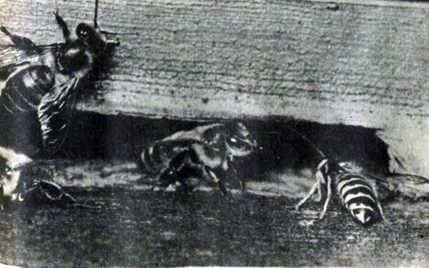
During the honey harvest the bees worked for a whole day: in the afternoon they collected nectar, at night they cooked honey from it. This hard work undermined their strength. Many perished, and the survivors were worn out and no longer able to endure the winter. Instinct tells insects how to rejuvenate the family. The entire burden of wintering and the future of the family rests on the bees that appeared in August and September.
These are, perhaps, the most vital bees, young and strong. The ability to nurse a new generation, build honeycombs, collect honey and pollen, they retain until next spring.
Again, as in the spring, bees strengthen attention to the uterus, abundantly feed it, provide a place for laying, releasing the middle of the nest from the honey. The younger the uterus, the longer; she puts the eggs.
Many believe that late-born bees because of weather conditions can not fly around and cause concern to the family in the winter, they seem to not live to spring and constitute the bulk of the debris – the dead bees. However, a lot of facts have been collected that deny this: bees born in the end of January – beginning of February 1, safely survive until the spring. By the way, young bees with unclean intestines go to winter not too much. Late overflights are not uncommon even in the northern regions. Currently, beekeepers have the idea of intensifying winter breeding, especially in the southern regions, so that by the spring they will have rejuvenated families. Therefore, all the means that contribute to the fall oviposition and extend it are used. The fodder stocks in the nest are strongly influenced by the rate and duration of laying.
Beekeepers noticed that in the spring the uterus continues to lay eggs with minimum feed reserves (5-7 kg) and even in cold and light-weather weather, and in autumn they stop clutching at considerable reserves (12-15 kg). In the spring, every day, more and more plants bloom and bees do not remain without food. And at the end of summer, when the last honey-plants bloom, one has to rely only on what is in the nest. That is why families with insufficient stocks of honey, relatively early stop growing brood.
Large fodder reserves are needed to increase the bee family not only at the end of the season, but also at the beginning of the next. They are a guarantee of higher honey collectors in the coming year. Therefore, in a multi-hull, 2 to 3 corpses are left, in Dadan hives – full nests, in sun loungers – 12 frames, batch families are given one body.
It is very important that bees can find at least a small amount of nectar. This keeps them active. Such supportive, stimulating late and autumn bribes contribute to the growth of the mass of young bees. Late migrations only justify themselves for this purpose.
Пчелы безматочный. Как очистить пчелиные рамки.
Young Beekeeper